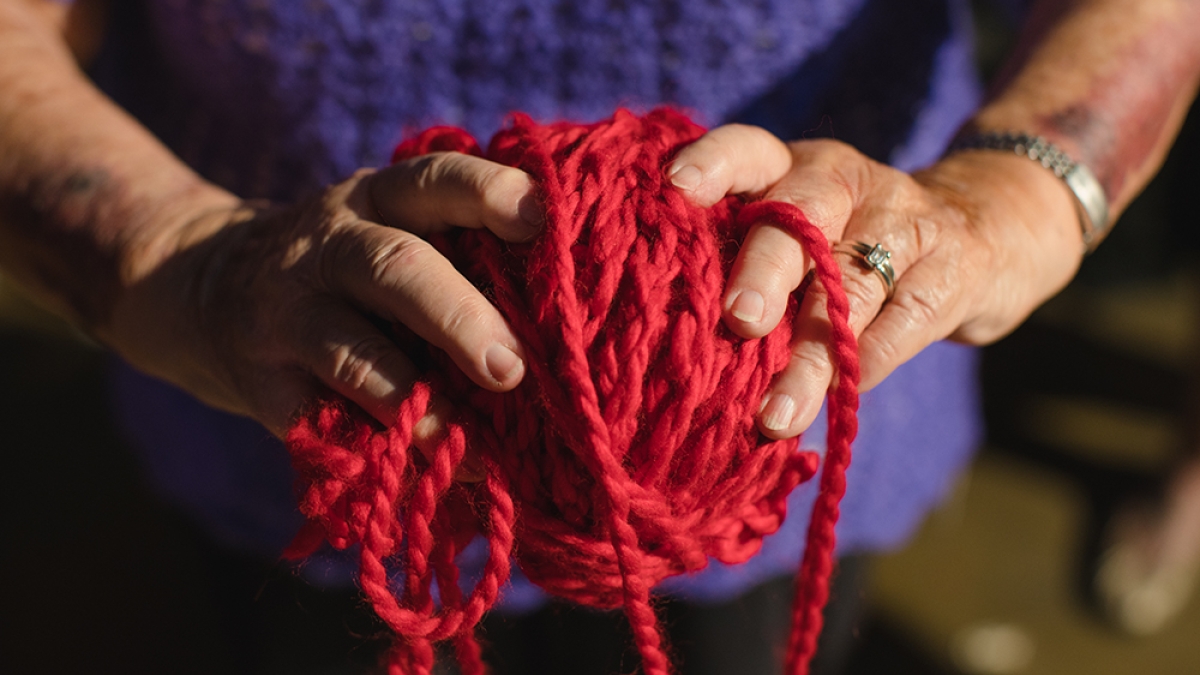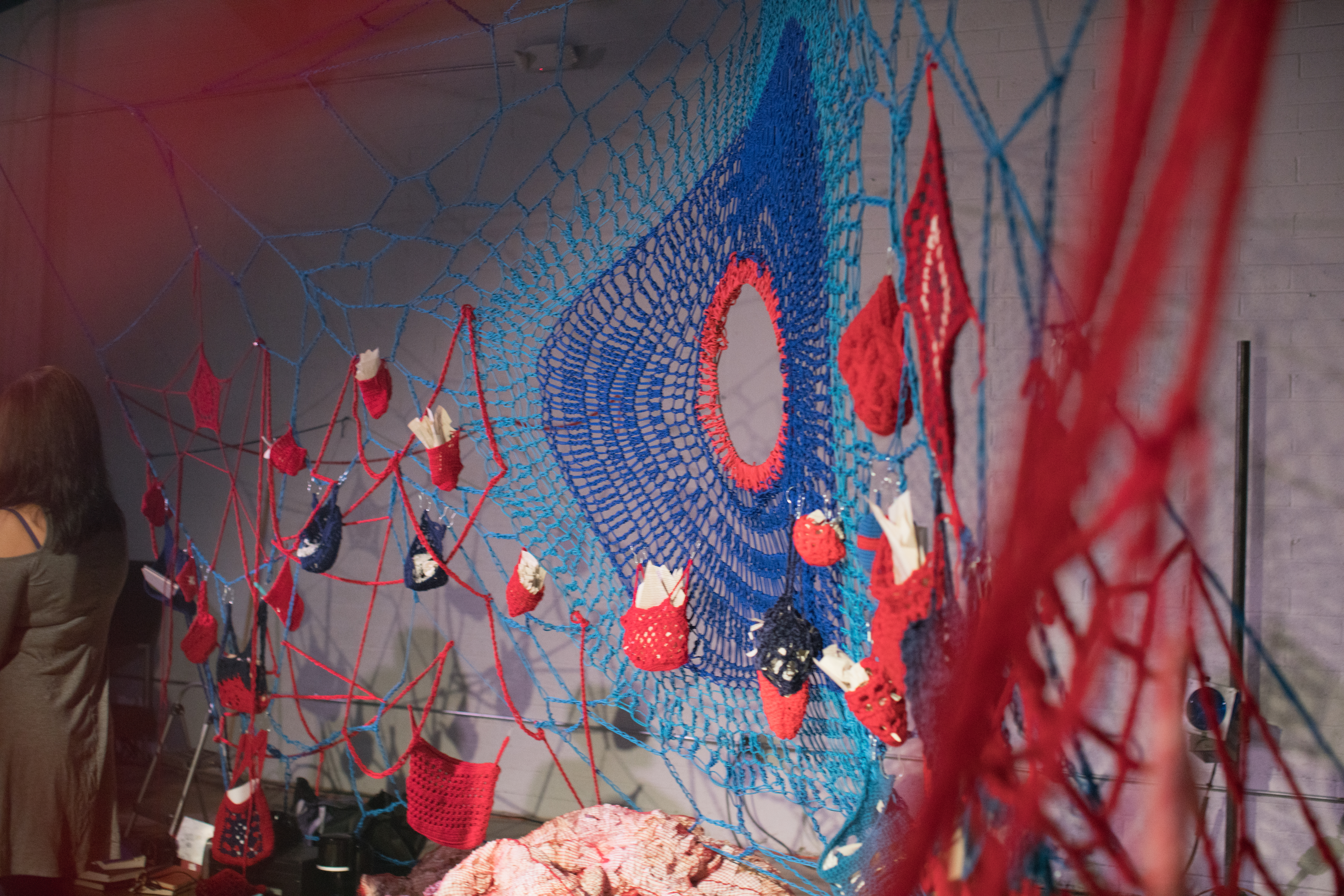Crocheting and big data might seem wholly unrelated, but for Arizona State University School of Film, Dance and TheatreThe School of Film, Dance and Theatre is part of the Herberger Institute for Design and the Arts. Assistant Professor Jessica Rajko, the intricate webs of ever-expanding yarn were the perfect metaphor for the elusive concept she’d been exploring in her multidimensional art project, "Me, My Quantified Self, and I," which asks the question: In our increasingly digital world, how do we perform data, and how does data perform us?
While learning to crochet and sharing her ideas about how it can help us understand data, Rajko struck a nostalgic chord with friends, colleagues and students, who were eager to share stories of time spent with grandparents and what it had taught them.
“It got me thinking about how we don’t really engage in intergenerational conversations around technology,” she said. “Often, if we talk about seniors and technology, we talk about them as not knowing about it.”
Connecting generations — with yarn
Enter "Digital Divide," Rajko's collaborative arts project that explores what seniors have to share with younger generations about digital culture.
From 2 to 5 p.m. Sunday, Dec. 10, massive swaths of crocheted yarn, knitted wool and quilted fabric will hang from the ceiling, dangle in the air and drape across the floor at the Tempe History Museum, each piece the result of a series of informal, intergenerational conversations — community textiles that summarize and represent community dialogue.
The project took place over the course of a few months, with local residents of all ages meeting once a week with seniors at the Pyle Adult Recreation Center in Tempe for two-hour quilting, crocheting and knitting circles.
The seniors are part of the community group Tempe Needlewielders, several of whom participated in Rajko’s February dance performance that served as the premiere of "Me, My Quantified Self, and I." "Digital Divide" is another iteration of that larger project.
Rajko said she initially reached out to the Needlewielders to participate in the dance performance because the question of how humans interact with technology doesn’t exclude the elderly, and she wanted her project to reflect that truth. Tablets, smartphones and other gadgets, she points out, aren’t age-specific.
“Everybody is implicated in technology, so I wanted to have them present,” she said. The conversation about big data and digital culture “is about people. But we often leave seniors out.”
An example of the type of textiles that will be on display Sunday, Oct. 10 at the final project showing of ASU Assistant Professor Jessica Rajko's community art project, "Digital Divide." Photo by Alonso Parra.
Interdisciplinary digital media and performance grad student Sharon McCaman, who danced in the project’s premiere, said their involvement forced her to challenge her own preconceived notions.
“It was interesting to talk to them about technology because we make assumptions about what that generation knows or understands … but they know more than we assume,” she said.
McCaman learned to crochet during rehearsals with the guidance of some of the Needlewielders, an experience that directly influenced her thesis exhibition. It will feature a room with crocheted walls, which, when touched, will produce digital sounds.
A collaboration of textiles, talk and technology
Following the dance performance, Rajko reached out to the Needlewielders again when she conceived of the idea for "Digital Divide." She had invited them into her space; now she wanted to experience theirs.
Not only did the opportunity add another layer to her overall project, it also gave her a chance to grow her relationship with members of the local community.
“This is part of us being responsible artists and researchers,” Rajko said. “Not just the university disseminating information outward, but making it a discourse and building sustainable relationships with the community over time.”
Before the "Digital Divide" meetings began, Rajko conducted a survey with the seniors asking about their relationship with technology. Some of their responses surprised her. One statement, “Technology makes me happy,” received a majority of “agree” or “strongly agree” responses.
“I got some really rich content from the survey,” Rajko said, which she used to establish a basis of understanding between the seniors and their younger visitors about what the elders of the group did and didn’t know about technology, and also to trigger discourse.
The data generated by the survey was used to design the textiles the group worked on while chatting about the Twitterverse and what it means to swipe left. Some of the pieces became lengthy rectangles that, when arranged side by side and hung from the ceiling, will create a giant bar graph representing information such as who prefers actual, face-to-face interaction over FaceTime.
The showing will also include a “data quilt,” made up of color-coded squares, each square representing a person, with their responses to survey questions etched onto it.
“It’s not just about what data is,” Rajko said, “but who it represents.”
Top photo: Martha Kasapis, a member of the Tempe senior group Needlewielders, holds a ball of yarn. Photo by Alonso Parra.
More Science and technology

ASU researcher part of team discovering ways to fight drug-resistant bacteria
A new study published in the Science Advances journal featuring Arizona State University researchers has found vulnerabilities in certain strains of bacteria that are antibiotic resistant, just…

ASU student researchers get early, hands-on experience in engineering research
Using computer science to aid endangered species reintroduction, enhance software engineering education and improve semiconductor material performance are just some of the ways Arizona State…

ASU professor honored with prestigious award for being a cybersecurity trailblazer
At first, he thought it was a drill.On Sept. 11, 2001, Gail-Joon Ahn sat in a conference room in Fort Meade, Maryland. The cybersecurity researcher was part of a group that had been invited…

